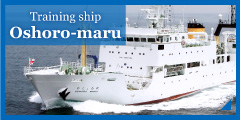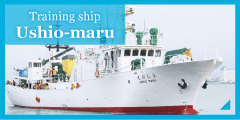Facilities
- BRIDGE / NAVIGATION & RADIO EQUIPMENT
- MACHINERY PART / MACHINERY AUTOMATION SYSTEM
- LIVING FACILITIES
- FISHERY FACILITIES
- LABORATORIES
- INBOARD LAN SYSTEM
- OBSERVATION & RESEARCH FACILITIES
Functions and features
The purposes for building the training ship Oshoro-maru V are to work on training and research regarding the fisheries sciences; to nurture human resources who can play an important role in this science field; to use for interchange of personnel and international collaborative research w ith domestic and foreign universities and research organizations; and to contribute to the reconstruction efforts of the fisheries industry that was devastated by the 2011 Tohoku earthquake and tsunami.
For these purposes of use, t he s hip has been designed and constructed as ” an ideal fishery training ship” that will be active for a long time and provide an environment for practice of world standard research and education.
The ship is also designed to s ucceed the high seaworthiness of the predecessor, Oshoro-maru IV, which had high sea-keeping and maneuvering performance, and furthermore, to have more sophisticated comfortability and ability for r esearch and training considering the environmental load reduction.
I. Basic Performance
Hull form and dynamic and static performance of the ship
- For the ship to have good propulsive and sea keeping performance, the height of the center of gravity was designed carefully, and a bulbous bow was adopted.
- A stern bulb was adopted to reduce the propeller-induced excitation force and the propeller cavitation.
- The hull form around the bow was carefully designed to suppress generation of air bubbles while sailing for t he underwater a coustic apparatus, which is arranged in the sonar dome intensively, and to exhibit good performance during the navigation for research and observation.
- The ship is equipped with a flap rudder and a bow thruster in order to improve the maneuverability at low-speed in the navigation for research and observation.
Reducing of the underwater radiation noise
- An electric propulsion system with two electric motors and one propeller was adopted.
- The propeller was designed to prevent cavitation from being generated in the navigation for research and observation at ship speeds less than 10 knots.
- The principle part of the hull structure is covered with v ibration damping material, and the electric generators are equipped with vibration isolating support.
- Low-noise type of auxiliary machinery and out fitting were chosen for the ship.
Improved living environment
- To reduce ship motion in rough seas, large bilge keels, anti-rolling tank and retractable fin stabilizers were installed.
- Adoption of the electric p ropulsion system much improves the silence characteristic.
- The living area was designed to acommodate female students and international researchers.
- The funnel was designed to prevent the smoke flowing over the exposed deck.
Propulsion and maneuvering system
- Two three-phase induction motors with two revolution speeds a s the electric propulsion motors give redundancy.
- Two of the three main diesel generators are generally used in the normal navigation considering easy maintenance.
- A joy-stick control system was installed to have various maneuvering modes with less operator’s work in the research and observation.
II. Instruments for fishing, research and surveys
Fishery facility
- The ship has a well deck like its predecessor, Oshoro-maru IV, for effective training of longline and driftnet fishing.
- The slipway in used for trawling, forms a part of the transom, and can be opened and closed with oil pressure.
Laboratories
- The ship is equipped with several exchangeable container-type laboratories for various research uses.
Instruments for research and observation
- Observations are carried out mainly on the port side, where equipment for research and observations is located for effective operation.
- The ship carries the latest s urvey instruments for m arine resources and oceanography such as a scientific echo sounder, a multi beam sonar, etc.
Measures for navigation in ice
- Preparing for navigation in northern areas, the hull structure, propeller, propeller shaft etc. were designed and manufactured based on the ice class IC.


